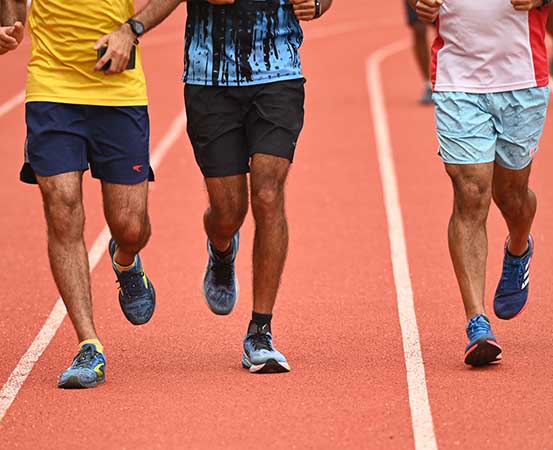
While running is a universal form of physical exertion, the choice, or rather, preference of where one runs, the distances covered, or the surface one prefers varies. Asphalt roads, concrete or synthetic tracks, grass trails and the treadmill, multiple choices exist. Some surfaces, especially the harder ones, are vilified as reasons for impact injuries and other niggles runners suffer.
So, is there an ideal surface to run, with minimal risks of stress or impact injuries? The answer lies not on the surface, say experts.
Running gait and form matter irrespective of the surface. So, runners should focus on getting those in place first, working with a coach. “It [proper gait, strides and technique] comes with practice, focusing on strengthening exercises, muscular endurance exercises, refining the hand movements and leg movements,” explains Mumbai-based running coach and ultramarathoner Kavin Kondabathini. “All of these aspects need to be worked on.”
Other aspects such as nutrition, rest, recovery, strength, cross-training and mobility drills play a role in building the body for injury-free and efficient runs, regardless of the surface. You must be aware of the strides and how you’re running, and pay attention to the form, as well as the other finer details.
However, different surfaces pose unique challenges.
Asphalt or tar road running
Tar or asphalt roads are the first choice for many simply because of their accessibility. And, contrary to the notion, tar roads do offer a bit of cushioning due to the layers in their structure. However, asphalt impacts the joints. The best way to negate this is by strength training and practicing the running technique.
In fact, experts say, the bigger threat while running on roads is not the surface — rather, it lies in the traffic hazards.
Running on a concrete surface
Running on a concrete surface leaves a greater impact on muscles and joints. “Concrete surfaces or cement roads are made in such a way that there is no gap in between the layers,” explains Chetan Sehgal, a UESCA (United Endurance Sports Coaching Academy) certified running coach from Delhi. “It is a hard surface right through, unlike asphalt which has gaps in between [the layers that create a cushioning effect]. Concrete, therefore, creates more impact while striding. Strength training is advised to equip the muscles.”
Impact while running on synthetic racetracks
Rubber or synthetic racetracks provide good traction. The body alignment and speed are better, too. However, not everyone will have ready access to a track, as these are mostly found in stadiums and sports institutions.
“Running on track requires muscular endurance,” adds Kondabathini, a two-time World Masters Games bronze medallist from India. “New runners can find it difficult to control their pace due to the bouncy effect. They will also not have the muscular endurance to maintain their speed for longer distances.”
A synthetic track absorbs impact and is bouncier, but it can be used for certain types of training. Speed, endurance and stamina training can be done on this track, for instance. But if you are a newbie and do not have the proper running gait, it could lead to injuries.
Striding on grass and mud
Running on grass and mud trails requires grip. When you stride on grass, especially during winters when the blades are wet with dew, it can be slippery. Thus, your shoes should have adequate treading to provide traction.
However, running on mud or grass will give a softer and smoother experience compared to other surfaces. Of course, one must be mindful of the hazards, including irregular surfaces, pebbles and thorns that could injure feet and damage footwear.
Running on sand or beaches
Running on sand requires more energy and muscular exertion. The surface does not offer cushioning. Instead, the feet sink in and add resistance to the run.
So, to run on sand, one needs strong glutes, hamstrings and ankles. “While running on sand, more muscles are firing and muscle motors are being recruited. Thus, it activates all the muscles, which helps to build better stamina and strength,” explains Sehgal.
Pick shoes based on the running surface
Runners need to wear shoes based on the surface they are running on.
“On the racetrack, short-distance runners can wear shoes with spikes,” informs Kondabathini. “However, for greater distances, long-distance running shoes are better.” Such shoes are also optimal for running on the road. “If you are choosing a surface like grass, dirt, rocks or sand, you will need shoes with grips or some lugs on the sole,” adds Sehgal.
What’s the ideal running surface for beginners?
For beginners, roads are best the surface to run on and refine their strides. They can also use grass or mud tracks because they absorb impact.
Later, to add variation, they can run on different surfaces and explore themselves as runners.
Takeaways
- Runners can run on various surfaces — asphalt, concrete, mud, sand, grass and synthetic tracks.
- Each surface has its pros and cons, and it is the technique that matters while running. If the base running technique is strong, the runner can attempt various surfaces while enjoying each outing.
- Besides technique, nutrition, rest, recovery, strength training, cross-training and mobility training are all essential while training to run.

















